 |


|
|
|
|
Interview by Jack Nichols
Throughout the decades, Barbara and Kay helped initiate and uphold a strategic militancy that was crucial to the American movement's earliest growth. She was in the forefront of the battle against now-discredited psychiatric theorizing. She stood on the ramparts in the earliest picketing demonstrations. Barbara founded the first East Coast chapter of the Daughters of Bilitis, the nation's original lesbian group. She became the editor of America's first lesbian movement magazine, The Ladder. Among her primary motives had been to make the process of coming out easier for closeted, distressed women and men. Today, her pioneering efforts have earned Barbara a much-deserved honor: the naming after her at the Independence Branch of the Free Library of Philadelphia, of a gay and lesbian collection that is housed, appropriately, within the very shadow of Independence Hall. Philadelphia, where Barbara has lived most of her life, is setting an example, honoring this amazing, indefatigable woman whose entire life has been dedicated to helping others. GayToday recommends that other library collections of gay and lesbian works be named after Barbara Gittings. The least we can do, in fact, is to thank her in a meaningful way, honoring her name wherever library collections of gay and lesbian books exist. Jack Nichols: Barbara, you've always especially loved books. They were your salvation when, as a young woman, you had no one to talk to about your feelings. One of the books that had a strong influence on you—and on a generation of gay men too, I'd wager—was Radclyffe Hall's The Well of Loneliness. I read it when I was fifteen. Radclyffe Hall became, until I met you and Kay, my movement heroine. Tell me about those difficult early times you had and how The Well of Loneliness affected you.
Jack Nichols: The Ladder, when you were its editor in the 1960s, was the movement's leading intellectual journal. It was the very first lesbian review, and the publication of America's first lesbian movement organization. You were bold, I remember well, never afraid of debate or controversy. Your life partner, Kay Tobin Lahusen, was the movement's earliest photo-journalist and her pictures of the then-un-heard-of picketing demonstrations appeared on the Ladder's cover. You ignored the conservative's cries to put a stop to the pickets and celebrated demonstrations instead, taking your stand in the field of direct action. Do your remember some of the movement political clashes that ensued? Barbara Gittings: A major clash was over picketing itself. Picketing was NOT a popular tactic in the 1960s, as it is now. Certainly our cause wasn't popular. Even many gay people thought our efforts were foolish and outlandish. One key writer for The Ladder told me, "Dirty, unwashed rabble are thought to do that sort of thing!"
Then we convinced a few live lesbians to be pictured back to camera or in shadowy profile. Finally we got full-face photos of lesbians! We wanted to show right on the cover that lesbians are normal, wholesome people. In the early 1960s many lesbians didn't know this; they had the same weird images of lesbians as the heterosexuals around them. So we showed real lesbians on our magazine covers for everyone to see. Jack Nichols: You've been an activist for 43 amazing years—since 1958. Kay has been active for almost as long as that. I'd should imagine you both have some pretty strong feelings about what's been accomplished since you first helped in so many crucial ways to launch our movement. You seemed always to be present at the right time and the right place on ever so many pivotal occasions. How does it feel today-- looking back over these decades of apparent progress?
For instance, when that Kansas minister who does anti-gay picketing recently picketed a gay bar, the bar owner recruited gays and supporters to pledge dollars for every minute the minister picketed. So our opponent was used to raise money for us, a neat twist! Jack Nichols: Mark Segal, the publisher of Philadelphia Gay News, recently said that he got goose bumps when you addressed an assemblage at the Independence Place branch of the Free Library of Philadelphia. You were being honored—a public library collection was being named after you—The Barbara Gittings Gay/Lesbian Collection. Segal said that chills were running up his back as you thanked the crowd. What did you say to that crowd? Barbara Gittings: "With this marvelous collection, today a gay person, or someone who's not gay, can find right away what I couldn't find many years ago: support for gay feelings and a positive view of gay love and the gay world.
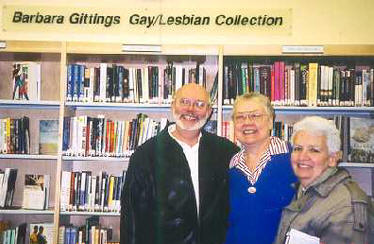 Barbara Gittings (center) with Ada Bello and John Cunningham. Mr. Cunningham heads the Branch Libraries for the Free Library
of Philadelphia and he conceived the Barbara Gittings Collection. Ms. Bello marched with Barbara in the 1960s pickets at
Independence Hall.
Barbara Gittings (center) with Ada Bello and John Cunningham. Mr. Cunningham heads the Branch Libraries for the Free Library
of Philadelphia and he conceived the Barbara Gittings Collection. Ms. Bello marched with Barbara in the 1960s pickets at
Independence Hall.
"Our gay civil-rights movement is a little over 50 years old. The earliest activists had to cope with the sickness label, the sin label, and the criminal label. But the overriding problem for decades was our invisibility. "We've come a long way in coping with that. And this collection--so big, so bold, so open--is a major breakthrough. We have to be visible to get equality and fair treatment. You've made us visible in a special way. And you have given me such a thrill. When I walked in today and saw this collection for the first time, it was a bit of heaven brought to earth for me!" Jack Nichols: You always worked well with men in the movement, Barbara,—especially Frank Kameny. The two of you teamed up on many occasions, facing the anti-gay Pit Bulls in the Pentagon together, for example, or the psychiatric shamans. You once ran an ad on the back cover of The Ladder, featuring Randy Wicker reading it, showing that movement men liked your publication too. You were never a lesbian-separatist, it seems. You envisioned our civil rights movement best served by lesbians and gay men working together. Isn't that true?
We have to fight for the right to be included in so many ordinary aspects of life. We have strong common cause. The proof of that is that today, the public face for a gay organization--its president or executive director or whatever--is as likely to be a woman as a man, and the human face for a gay issue as often a woman as a man. Jack Nichols: One of the things you've loved most in your life has been your singing. You used to go each week, I recall, and sing classics in a Philadelphia choir. Recently you and Kay attended a gathering on the West Coast, all of the lesbian and gay choral groups singing together in one spot. Tell me how singing has enlivened your life. Barbara Gittings: Singing has always sustained me. I flunked out of college in my first year because I quit going to classes while I searched libraries for material on homosexuality. But I kept up with Glee Club and it kept me going through a rough time....I still sing with the Philadelphia Chamber Chorus, I've been with the group since 1952! My favorite music is Renaissance and Baroque.
Barbara Gittings: Roz Regelson believed in a gay liberation that opened up options for gay people to live as they saw fit, not as they were told was politically correct. This went against some of the prescriptive ideology of the times which dictated how gay people should live and think. Roz was a passionate civil libertarian who wasn't afraid to put down what she called in 1971 "the vulgar New Left." Jack Nichols: Kay's historic 1972 book, The Gay Crusaders, tells how you and I shared the stage at Bucknell University in early 1967, giving a gender-equal (lesbian liberationist and gay male together) civil rights speech. Since then you've spoken at countless universities and other places too. What have been some of the other public occasions—like being co-Grand Marshall at New York City's Pride Parade in 1997—that you like to recall today? Barbara Gittings: Being co-Grand Marshal at New York's 1997 Gay Pride March was indeed a triumph. So many people all in the open, so much cheering, so much gay energy and enjoyment! My arms ached for two days from waving back, and I lost my voice from shouting back. I loved it but kept thinking of what made possible that great celebration: years of explaining to non-gays that we are normal and moral and healthy, years of stirring up gay people's gumption to tackle our problems. Jack Nichols: Tell me how you met your beloved Kay. She's been the strongest possible helpmeet for you, contributing often behind the scenes to our movement's successes in ever so many ways. She was a co-founder, even, of New York's successful Gay Activists Alliance. Lige once told me that he considered the two of you to be the Gertrude and Alice of our generation. She joined right in with you in movement work almost from the start, didn't she? Barbara Gittings: Yes, Kay is the wind beneath my wings and I'm the wind beneath her wings. We've flown together since we met in 1961! Jack Nichols: A stellar documentary is being completed about the early pickets in which we all took part. Its creator is a youthful filmmaking genius. You, Frank, Lilli, Randy and I were all interviewed at length by him and we're all together again as talking heads in this documentary. Seeing a promo for it made me very happy at our all being united on film after these many years. Do you know the documentary's finalized title or anything about when it might be shown? Barbara Gittings: The documentary is called Gay Pioneers and is expected to be finished and shown on PBS in summer 2001. The filmmaker is Glenn Holsten of WHYY-Channel 12 in Philadelphia. Jack Nichols: If you were advising a young woman or a young man today—what essential message would you want to communicate? Do you think their coming out has been made easier than it once was?
Jack Nichols: What kind of futureworld do you envision, Barbara, as a result of your life's work? Barbara Gittings: I'd like to see our gay-rights movement go out of business because its work is done. Then we can be ourselves without extra effort. As gays we'll continue to be a special group because we enjoy being together, but we won't have to struggle to get the bigots off our backs. Free at last! |

© 1997-2002 BEI
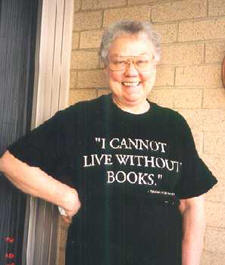 Barbara Gittings was the first true lesbian and gay
activist. She joined the fledgling movement in 1958
and, shortly afterwards, with the unflagging
assistance of the great love of her life, Kay Tobin
Lahusen, she emerged as one of its most articulate
representatives.
Barbara Gittings was the first true lesbian and gay
activist. She joined the fledgling movement in 1958
and, shortly afterwards, with the unflagging
assistance of the great love of her life, Kay Tobin
Lahusen, she emerged as one of its most articulate
representatives.
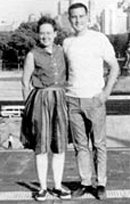
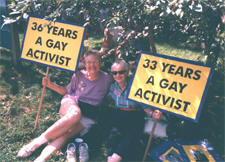 Barbara Gittings with her beloved Kay Tobin Lahusen, 1994
Barbara Gittings with her beloved Kay Tobin Lahusen, 1994 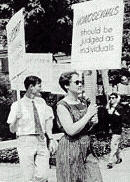 Randy Wicker and Barbara Gittings
Randy Wicker and Barbara Gittings 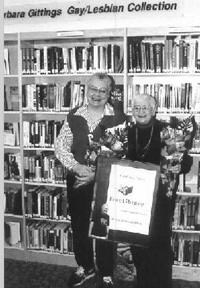 Barbara Gittings and Kay Tobin Lahusen
Barbara Gittings and Kay Tobin Lahusen 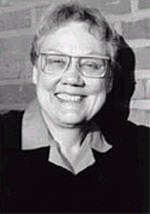 Barbara Gittings: Coming out is still a personal decision for each individual.
Fortunately, today you are not alone and there is help. Take what help you
need--and pass some along. Consider your talents and find a niche to use
them to make a difference.
Barbara Gittings: Coming out is still a personal decision for each individual.
Fortunately, today you are not alone and there is help. Take what help you
need--and pass some along. Consider your talents and find a niche to use
them to make a difference.